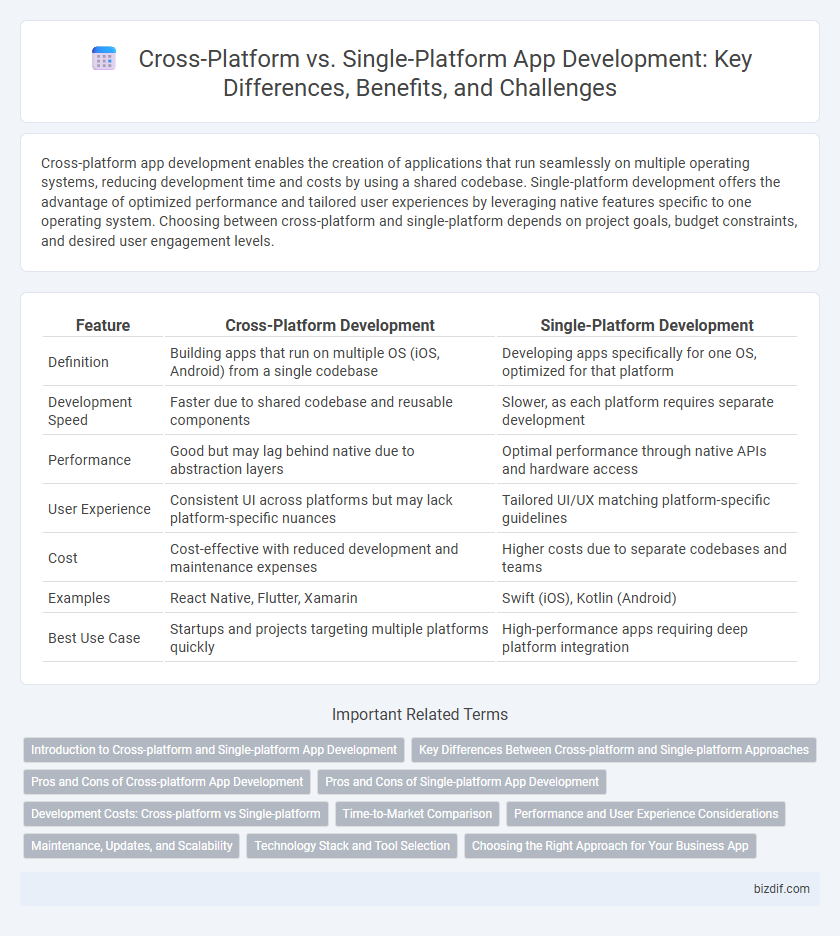Cross-platform app development enables the creation of applications that run seamlessly on multiple operating systems, reducing development time and costs by using a shared codebase. Single-platform development offers the advantage of optimized performance and tailored user experiences by leveraging native features specific to one operating system. Choosing between cross-platform and single-platform depends on project goals, budget constraints, and desired user engagement levels.
Table of Comparison
| Feature | Cross-Platform Development | Single-Platform Development |
|---|---|---|
| Definition | Building apps that run on multiple OS (iOS, Android) from a single codebase | Developing apps specifically for one OS, optimized for that platform |
| Development Speed | Faster due to shared codebase and reusable components | Slower, as each platform requires separate development |
| Performance | Good but may lag behind native due to abstraction layers | Optimal performance through native APIs and hardware access |
| User Experience | Consistent UI across platforms but may lack platform-specific nuances | Tailored UI/UX matching platform-specific guidelines |
| Cost | Cost-effective with reduced development and maintenance expenses | Higher costs due to separate codebases and teams |
| Examples | React Native, Flutter, Xamarin | Swift (iOS), Kotlin (Android) |
| Best Use Case | Startups and projects targeting multiple platforms quickly | High-performance apps requiring deep platform integration |
Introduction to Cross-platform and Single-platform App Development
Cross-platform app development enables developers to create applications that run on multiple operating systems, such as iOS and Android, using a single codebase, which reduces development time and costs. Single-platform app development involves building apps specifically for one operating system, allowing for optimized performance and better integration with native features. Choosing between cross-platform and single-platform development depends on project goals, target audience, and resource availability.
Key Differences Between Cross-platform and Single-platform Approaches
Cross-platform app development enables code reuse across multiple operating systems, reducing development time and cost while ensuring consistent user experience on iOS, Android, and web platforms. Single-platform development offers optimized performance and deeper integration with specific OS features, resulting in superior speed, user interface customization, and access to native APIs. The choice between cross-platform frameworks like React Native or Flutter and native development depends on project requirements, budget, and target audience preferences.
Pros and Cons of Cross-platform App Development
Cross-platform app development enables the creation of applications compatible with multiple operating systems like iOS and Android using a single codebase, significantly reducing development time and costs. However, it may encounter performance limitations and less access to device-specific features compared to single-platform development, which allows for optimized user experience tailored to a particular platform. Developers must weigh the benefits of faster deployment and lower expenses against potential compromises in app responsiveness and platform-specific functionality.
Pros and Cons of Single-platform App Development
Single-platform app development offers optimized performance and user experience by leveraging platform-specific features and APIs, resulting in faster execution and smoother interfaces. It ensures better security and easier maintenance due to a unified codebase tailored for one operating system but increases development time and cost if targeting multiple platforms separately. Limited reach and higher overall investment are significant drawbacks when compared to cross-platform solutions, which provide broader audience access with shared code.
Development Costs: Cross-platform vs Single-platform
Cross-platform app development typically reduces overall development costs by allowing a single codebase to run on multiple platforms like iOS and Android, minimizing the need for separate teams and resources. Single-platform development, while often requiring higher initial investment due to platform-specific customization, can lead to better performance and user experience tailored to individual OS requirements. Budget allocation must consider long-term maintenance expenses, as cross-platform apps may incur additional costs for handling platform discrepancies and updates.
Time-to-Market Comparison
Cross-platform app development significantly reduces time-to-market by enabling simultaneous deployment across multiple platforms such as iOS and Android using a shared codebase. Single-platform development requires building and maintaining separate codebases for each platform, leading to longer development cycles and delayed releases. Leveraging frameworks like React Native or Flutter accelerates launch timelines, optimizing resource allocation and enhancing overall efficiency.
Performance and User Experience Considerations
Cross-platform app development offers broader device compatibility but may face performance bottlenecks due to abstraction layers, potentially impacting user experience with slower load times and reduced responsiveness. Single-platform development allows optimization for specific operating systems, resulting in smoother performance, faster execution, and tailored user interface elements that enhance overall user engagement. Performance metrics like frame rate stability and memory usage are typically superior in single-platform apps, while cross-platform solutions prioritize development efficiency over fine-tuned user experience.
Maintenance, Updates, and Scalability
Cross-platform app development simplifies maintenance by enabling a single codebase that updates seamlessly across multiple devices, reducing time and resource investments. Single-platform apps offer tailored updates and optimizations, enhancing performance but requiring separate maintenance cycles, which can increase overhead. Scalability in cross-platform solutions accelerates deployment across diverse environments, while single-platform projects provide deep customization but may limit rapid expansion.
Technology Stack and Tool Selection
Cross-platform app development leverages frameworks like Flutter, React Native, and Xamarin, enabling code reuse across iOS and Android, which reduces development time and costs. Single-platform development uses native technologies such as Swift for iOS and Kotlin for Android, providing optimal performance and full access to platform-specific features. Choosing between cross-platform and single-platform depends on factors like project complexity, performance requirements, and the desired user experience.
Choosing the Right Approach for Your Business App
Selecting between cross-platform and single-platform app development depends on business goals, target audience, and budget constraints. Cross-platform frameworks like React Native and Flutter enable faster deployment and broader reach by sharing code across iOS and Android, whereas single-platform development offers optimized performance and deeper integration with specific OS features. Prioritizing user experience, maintenance costs, and scalability helps determine the most effective approach for your business app's success.
Cross-platform vs Single-platform Infographic

 bizdif.com
bizdif.com